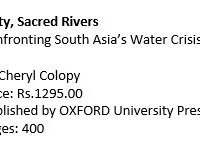
The Ganges or river Ganga is the lifeline for a billion plus population. It is a part of culture, a sacred river of South Asia. However, due to growing human assaults, the river is getting dirty and dying.
The Ganges and its tributaries are sources of livelihood for a billion plus population. They are religiously sacred for a billion plus Hindus all over the word. However, as the river is gradually dying due to growing human activities and intervention, the associated culture and religious values are on the verge of death too.
As the population increases, water crisis in South Asia is looming large. The Dirty, Sacred Rivers explores South Asia’s water crisis, taking readers on a journey through North India, Nepal and Bangladesh between the Himalayas and the Bay of Bengal.
The Ganges not only provides water to drink and irrigate the land but it is also a part of great Hindu civilization. From the sources till it reaches the Bay of Bengal, the river water touches three countries, Nepal, India and Bangladesh, and passes through historic and religious places.
There is no dearth of books related to water pollution, and religious and cultural values of the Ganges and its tributaries. However, American journalist Cheryl Colopy is the first writer to describe the state of South Asia’s most scared river Ganga and its tributaries in an authentic manner after visiting the sources and the entire basin areas. Many books have already been published about the population. This book narrates the suffering of the Ganges and its tributaries at the hands of the humans and at the cost of its very life.
To describe the state of rivers, journalist Colopy treks to high mountain glaciers with hydrologists, bumps around the rough embankments of India’s poorest state in a jeep with social workers, and takes a boat excursion through the Sunder bans, the mangrove forests at the end of the Ganges watershed.
In the words of Peter Gleick, co-founder and president of the Pacific Institute for Studies in Development Environment, Environment and Security, “ There is no doubt that we need good science and policy to save the world’s great rivers from destruction. But, Colopy’s moving experiences along Asia’s magical rivers from their mountainous headwaters to their broad deltas remind us that science and policy alone are not enough- we must regain our sense of the sacred and spiritual – and the her fine book helps us do that.”
Despite several attempts and commitments from various level, the Ganges, sacred river of South Asia, and a source of livelihood of billion plus population is close to die when it reaches at the plains and it is heavily exploited at its sources through construction of dams and hydropower stations.
In the words of Dipak Gyawali, former Minister of Water Resources of Nepal, “River Ganges defines the essence of the Indic civilization and Cheryl Colopy has travelled its entire length from its icy heights in Nepal to the hot plains of India and Bangladesh. This valuable book describes her struggle to understand how a civilization based on a reverence for the river’s sacredness can today turn it into a sewer. Outsiders can appreciate the bewildering forces that roil this densely populated region while South Asians –most of whom have never made such an integrated journey themselves-will find in it a mirror that speaks of the pain and beauty of committed social and environmental struggle that lie behind the grime on the surface.”
Cheryl spent almost a decade to write the book travelling from Gomukh, glacier of Ganga to Nepal’s world known glaciers Tsho Rolpa and other glaciers of Khumbu region learning the experiences of the people. She visited hydropower sites along the Uttarakhand of India as well as its capital New Delhi to see the state of water.
Writer Cheryl describes how modernization of cities and rising income with global warming threatened the rivers. The writer visited construction of dam sites and hydro power projects describing how they are destroying river eco-system. She also describes how dams and ill-advised embankments were destroying the Ganges and its sacred tributaries. She extensively trekked mountains of Uttarakhand of India. She also narrates the pathetic story and destruction of mountain eco-system, livelihood and culture following the construction of Tehri Dam in Uttarakhand. She also visited New Delhi and interviewed people from across sections to describe the water mismanagement and water treatment.
Colopy narrates her vivid first-person experiences of looking at the complexity of life, culture, religion and eco-system of the Ganges River and its tributaries. At a time when there is a growing concern over polluted river and scarcity of water from Nepal’s capital Kathmandu to Indian capital New Delhi and many parts Bangladesh along with the major mega cities and religious sites of India, this book is an asset for all. The book is the first of its kind which derives its authenticity from observation of places of the Ganga river basin.

Keshab Poudel
Poudel is the editor of New Spotlight Magazine.
- IWMI: SoLAR Global Science-Policy Forum Conference
- Apr 25, 2024
- CLA: Samriddhi For Skill Development
- Apr 23, 2024
- ECONOMY: Growth At 3.3
- Apr 16, 2024
- DPM’s SHRESTHA’S CHINA VISIT High Profile, Low Key
- Apr 14, 2024
- Maha Kumbha In Barahkshetra: A Sacred Festival In Sacred Koshi (Kaushiki) River
- Apr 09, 2024
















